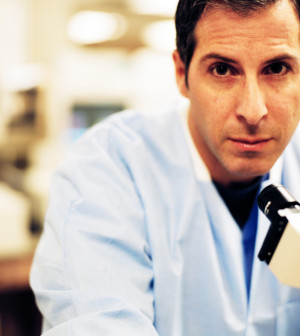- Skip Storing This Everyday Product in the Fridge Door
- Green Tea + B3 Pairing May Boost Brain Health
- Navigating Your Midlife Crisis: Embracing New Possibilities
- City Raccoons Showing Signs of Domestication
- Mapping the Exposome: Science Broadens Focus to Environmental Disease Triggers
- One Week Less on Social Media Linked to Better Mental Health
- Your Brain Changes in Stages as You Age, Study Finds
- Some Suicide Victims Show No Typical Warning Signs, Study Finds
- ByHeart Formula Faces Lawsuits After Babies Sickened With Botulism
- Switch to Vegan Diet Could Cut Your Greenhouse Gas Emissions in Half
One Woman’s Cancer Battle Highlights Promise of New Treatment


Just over two years ago, Melinda Bachini decided she was done with chemotherapy to treat her cholangiocarcinoma — a rare cancer of the bile duct that runs from the liver to the intestines.
At that point, she’d gone through three rounds of chemo, with little to show for it except side effects. The cancer was in her liver and lungs, and the outlook was grim.
“I knew if I was going to beat this, it would have to be with an experimental therapy,” said Bachini, a mother of six who was diagnosed at the age of 41 — on her son’s 14th birthday.
So Bachini did what most of us do when we want information: She went online, where she “stumbled upon” a clinical trial at the U.S. National Cancer Institute (NCI). It was testing an experimental therapy against advanced cases of gastrointestinal cancers; the idea was to use people’s own immune system T-cells to fight their genetically unique cancer.
“It made sense,” Bachini said. “It’s your own body doing what it’s supposed to do. I told my husband this was it.”
In March 2012, Bachini was accepted into the trial and soon began the treatment, known as adoptive cell therapy. Now her case is being reported online May 8 in the journal Science — in what experts call a “blueprint” that could be translated into therapies for the most common cancers out there.
“It’s still highly experimental,” cautioned Dr. Steven Rosenberg, the senior NCI researcher on the study.
But, he said, Bachini’s case “opens the door” to developing personalized treatments that harness the immune system to target specific mutations in individual cancers.
There’s nothing new about immunotherapy — the general term for any treatment that boosts the immune system’s cancer-fighting capacity.
But in the past several years, new techniques have allowed “huge progress” against melanoma and kidney cancers, said Dr. Steven O’Day, an immunotherapy expert who was not involved in the study.
Melanoma and kidney cancer are, by nature, relatively susceptible to the immune system, explained O’Day, who sits on the cancer communications committee of the American Society of Clinical Oncology.
“But [immunotherapy] has had much less success against the common epithelial cancers,” O’Day said. Epithelial tumors account for over 80 percent of all cancers, include Bachini’s type of cancer, and such major ones as colon, lung, breast and prostate cancers.
“Those cancers stay hidden from the immune system much better,” O’Day explained.
That’s why the success in Bachini’s case is a “breakthrough,” he said.
“This is a very exciting proof-of-principle that we can use the tools working so well now in melanoma, and apply them to other cancers,” O’Day said.
However, he stressed, “we’ve still got a long way to go.”
To treat Bachini, Rosenberg’s team started by analyzing T-cells in tumor samples from her lungs. It turned out that some of those T-cells reacted to a specific mutated protein in her cancer.
The researchers then produced an army of those T-cells in the lab, and infused Bachini with over 42 billion of them — about one-quarter of which were reactive to the mutation. That was enough to halt the growth of her liver and lung tumors for a year, when the disease began to progress again.
So Bachini got a second treatment, but this time nearly all of the T-cells were reactive to the mutation. That treatment, which was done over six months ago, quickly started shrinking the lung and liver tumors.
And they are still regressing, Rosenberg said.
According to Bachini, the chronic cough that once plagued her disappeared about a week after the treatment. “Now I’m able to walk two miles a day with my dog,” she said. “And I skied a lot this winter.”
Bachini does have nerve damage in her hands and feet — a lingering side effect of her chemotherapy.
And there is still a long road ahead, for both Bachini and this therapy. Even if future studies find the approach effective in various cancers, it will not be like giving a drug.
The specific gene mutations that trigger a T-cell reaction will vary from person to person — even when they have the same cancer, Rosenberg explained. The process of creating individualized T-cell therapies for every patient is no small task.
Yet that complexity is also the “beauty” of immunotherapy, Rosenberg said. With cancer, he noted, the “holy grail” is to have treatments that are fine-tuned to kill a patient’s cancer cells but leave healthy ones alone.
“This will be challenging to implement in the real world,” Rosenberg said. “But it’s doable.”
In fact, he and O’Day said, the ultimate hope is that immunotherapy will replace chemotherapy for many cancers.
As for Bachini, she hopes her experience ends up helping others. “There’s nothing I want more than for this to be successful for other people,” she said.
More information
The American Cancer Society has more on immunotherapy.
Source: HealthDay
Copyright © 2025 HealthDay. All rights reserved.










